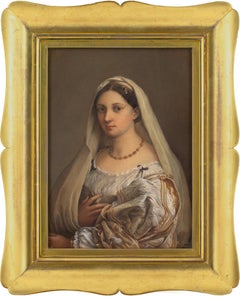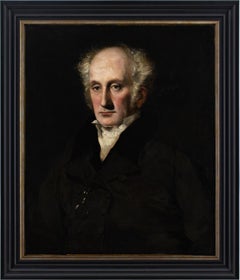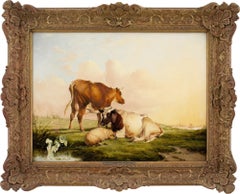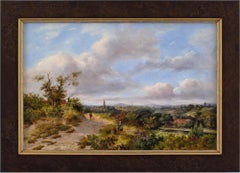Brave Fine Art
to
47
27
24
18
15
9
8
7
7
7
7
7
6
6
5
4
4
4
4
3
3
3
3
3
2
1
1
1
1
1
1
1
1
1
1
1
1
2
1
1
1
1
Girolamo Tubino After Raffaello, Sanzio Da Urbino La Velata
Located in Cheltenham, GB
This fine mid-19th-century watercolour by Italian artist Girolamo Tubino (1805-1879) is after ‘La Velata’ (Woman with a Veil) by Raphael (1483-1520),...
Category
1840s Old Masters Portrait Drawings and Watercolors
Materials
Watercolor, Paper
John Robert Wildman, Portrait Of A Gentleman
Located in Cheltenham, GB
This mid-19th-century oil painting by British artist John Robert Wildman (1788-1843) depicts a gentleman wearing a dark brown frock coat with waistcoat, white shirt and cravat. He be...
Category
1840s Portrait Paintings
Materials
Oil, Canvas
Thomas Sidney Cooper RA, Livestock In A Landscape With River Beyond
By Thomas Sidney Cooper
Located in Cheltenham, GB
This fine mid-19th-century oil painting by British artist Thomas Sidney Cooper RA (1803-1902) depicts two cows and a sheep in a landscape. Cooper was a distinguished painter of the n...
Category
1850s Victorian Animal Paintings
Materials
Oil, Canvas
Oscar Torna, River Landscape, Grez-Sur-Loing, Nocturne
Located in Cheltenham, GB
This late-19th-century oil painting by Swedish artist Oscar Torna (1842-1894) depicts a river landscape at Grez-Sur-Loing, France, under moonlight. Torna was an important figure in t...
Category
1870s Naturalistic Landscape Paintings
Materials
Oil, Canvas
Johannes Philippus Galjaard, Figures On A Rural Track With Town Beyond
Located in Cheltenham, GB
This charming mid-19th-century oil painting by Dutch artist Johannes Philippus Galjaard (1812-1867) depicts several figures on a rural track with a town and distant hills beyond. Hai...
Category
1850s Dutch School Landscape Paintings
Materials
Wood Panel, Oil
George William Mote, Near Guildford, Surrey
By George William Mote
Located in Cheltenham, GB
This late 19th-century oil painting by British painter George William Mote (1832-1909) depicts a shepherd and his flock before an extensive view across the Surrey countryside near Gu...
Category
1880s Victorian Landscape Paintings
Materials
Oil, Canvas
George Clint ARA (Attributed), Portrait Of A Lady In A Brown Dress
Located in Cheltenham, GB
This early 19th-century half-length portrait attributed to British artist George Clint ARA (1770-1854) depicts a young lady wearing a beautiful brown dress, bonnet decorated with small flowers, gold earrings and coral necklace. Clint was a distinguished painter and mezzotint engraver predominantly known for portraiture and dramatic scenes.
Set before an evocative classically-inspired backdrop, she looks out from across the centuries with a composed demeanour. Adorned in the latest fashions, oversized ‘gigot’ sleeves, a delicately-poised bonnet, and a coral necklace for good luck. It’s a charming portrayal by a masterful hand.
Born at Drury Lane, in the heart of London’s West End, George Clint was destined to lead an exuberant life amid the spectacle of theatreland. His father, Michael Clint, was a hairdresser during a time of “hair pomatum, whalebone, wire, lace gauze, and feathers” - so young George would have encountered a variety of ‘characters’ during his childhood.
But despite these elevated surroundings, he soon discovered the darker side of London when thrust into the world of employment. Apprenticed initially as a fishmonger, he trained under a ferocious master who was known to beat him. The hours were unsocial, the conditions rank, and the work was brutal. He soon quit but subsequently found himself toiling for a corrupt attorney who demanded he undertake unscrupulous acts on his behalf.
Seeking a less volatile role, he turned next to house painting, at which he excelled. Commissioned, among other projects, to paint the stones of the arches in the nave of Westminster Abbey. Aside from an incident whereby he almost fell from the second story of a building, all was going well.
Following his marriage in 1792 to Sarah Coxhead, a farmer’s daughter, he began work in earnest as a painter of miniatures, determined to forge a career. Robert William Buss’ memoir celebrates Clint’s success as a miniaturist, stating that “great manual excellence was united with that chaste, delicate feeling for female beauty which characterised all Mr. Clint's portraits of ladies.”
Until this point, it appears he was predominantly self-taught, presumably constrained by a lack of finances. But from hereon in, his industrious nature coupled with several fortunate encounters, led to him developing an enviable talent for both painting and engraving. During the early 19th-century, the acquaintances one kept could make or break your fortunes and perhaps acutely aware of this, Clint’s ‘society’ was an ever-evolving circle of influential personalities.
He was “initiated into the mysteries of engraving” by Edward Bell (act.1794-1819) and produced numerous works after the foremost artists, such as George Stubbs, John Hoppner, and Thomas Lawrence. Following a commission from Lawrence, he struck up a long-term friendship.
Admired for his skill as a mezzotint engraver, he sought next to hone his technique in oils and, as with many aspiring portraitists, his first work in this respect was a depiction of his beloved wife. The pair were both delighted with it, yet over time Clint began to doubt himself and sought the validation of a superior hand - that of Sir William Beechey (1753-1839). However, paralysed with insecurity, he couldn’t face the potential criticism, so his wife took it instead - “with a child under one arm and the portrait in the other”. The result was immeasurably more positive than he’d envisaged and he became closely associated with Beechey until his death in 1839.
Numerous commissions followed from the landed gentry including Lord Egremont, Lord Spencer, and Lord Essex. But also from the theatrical community who would fill his studio at 83 Gower Street, Bloomsbury. His connections within the world of acting led to notable works such as ‘Malvolio and Sir Toby’ (from William Shakespeare's 'Twelfth Night', Act II, Scene iii)’ and ‘Harriet Smithson as Miss Dorillon, in Wives as They Were, and Maids as They Are’.
While his efforts in mezzotint included several contributions to JMW Turner’s Liber Studiorum.
As a measure of his success, Clint was elected an Associate of the Royal Academy in 1821 - a position he later relinquished for personal reasons. Today, he’s represented in numerous public collections including at The British Museum, Harvard Art Museums, The Met, V&A, Yale Center for British Art, and the National Portrait Gallery.
“The respect in which he was held, not only by his brother artists, but by an immense number of eminent men in various professions, and others of the highest rank, was the result of a rare combination of talent, candour, suavity of manner, and integrity of purpose”. [Obituary, 1854].
Housed in a period gilt frame, which is probably original.
Learn more about George Clint ARA in our directory.
Labels & Inscriptions: Supplier’s stencil from Rowney & Forster. The National Portrait Gallery holds a database of supplier’s stencils over the decades. The one here is also presented on two other works by George Clint. ‘Falstaff’s Assignation with Mrs Ford...
Category
1830s English School Portrait Paintings
Materials
Oil, Canvas
Arturo Orselli, The Flirtatious Huntsman
By Arturo Orselli
Located in Cheltenham, GB
This charming late 19th-century oil painting by Arturo Orselli (fl. 1880-1896) depicts a huntsman wearing riding gear conversing somewhat flirtatiously with two ladies.
Attired in o...
Category
1890s Figurative Paintings
Materials
Oil, Canvas
K & K Hof Atelier Pietzner, Family Portrait In A Garden Setting
Located in Cheltenham, GB
This early 20th-century mixed media by K & K Hof Atelier Pietzner of Vienna depicts a respectable family within a neoclassical garden setting.
With the advent of photography, afflue...
Category
Early 1900s Art Nouveau Mixed Media
Materials
Paper, Watercolor, Gouache, Photographic Paper
Richard Earlom After Jan Van Huysum, Still Life With Flowers
By Richard Earlom
Located in Cheltenham, GB
This beautiful early 20th-century aquatint is after an 18th-century engraving by Richard Earlom (1743-1822) of a work by the Dutch master, Jan Van Huysum...
Category
1910s Dutch School Still-life Prints
Materials
Aquatint, Paper
Early 19th-Century Central European School, Christ The Saviour
Located in Cheltenham, GB
This early 19th-century central European oil painting depicts Christ The Saviour standing atop an orb and carrying a cross over his left shoulder.
An unusual composition, Christ’s rather striking posture is perhaps more ‘Saturday Night Fever’ than it is sacramental. However, the iconography is archaic and derived ultimately from New Testament illustrations dating to the Middle Ages. Depictions of orbs are usually symbolic of the universe, while the cross alludes to redemption. Hence, it’s a visual representation of Christ as the Saviour of humanity.
Francisco de Zurbarán...
Category
1830s Portrait Paintings
Materials
Oil, Canvas
William Kay Blacklock ARCA, Continental Farmhouse In Summer
Located in Cheltenham, GB
This charming early 20th-century watercolour by eminent British artist William Kay Blacklock ARCA (1872-1924) depicts an elderly lady carrying a basket and parasol before a farmhouse...
Category
1920s English School Landscape Drawings and Watercolors
Materials
Watercolor, Paper
George H Hay, Spinning Wool, Watercolour
Located in Cheltenham, GB
This late 19th-century watercolour by Scottish artist George H Hay RSA (1831-1912) depicts four young ladies, wearing outfits synonymous with the 1820s, spinning wool within a simple...
Category
1890s Romantic Figurative Drawings and Watercolors
Materials
Watercolor, Paper
Boris Sporykhin, Interior With Girls Reading, Drawing
Located in Cheltenham, GB
This mid-20th-century drawing by Russian artist Boris Sporykhin (1928-2020) depicts two girls reading within an interior. They also appear in an earlier oil painting, so it’s plausib...
Category
1950s Figurative Drawings and Watercolors
Materials
Pencil, Paper
19th-Century Austrian School, Lady Riding A Grey Mare
Located in Cheltenham, GB
This charming mid-19th-century European watercolour depicts a young lady riding a grey mare before a view of Berg Perchtoldsdorf, Austria.
During the 19th century, aristocratic wome...
Category
1860s Victorian Figurative Drawings and Watercolors
Materials
Gouache, Watercolor, Paper
Alfred Walter Williams, Barmouth Sands, North Wales, Oil Painting
Located in Cheltenham, GB
This late 19th-century oil painting by British artist Alfred Walter Williams (1824-1905) depicts an expansive view across Barmouth Sands in North Wales.
The relaxed golden sands str...
Category
1880s Victorian Landscape Paintings
Materials
Oil, Canvas
Edward A Swan, Turbulent Marine Scene, Watercolour
Located in Cheltenham, GB
This fine late 20th-century watercolour by British artist Edward A Swan (b.1935) depicts two sailboats buffeted by turbulent conditions. Beyond, the hazy form of a frigate under full...
Category
1980s English School Landscape Drawings and Watercolors
Materials
Watercolor, Paper
Edmond Albert Joseph Tyrel de Poix, Landscape With Pub & Signpost
Located in Cheltenham, GB
This charming 19th-century drawing by British artist Edmond Albert Joseph Tyrel de Poix (1840-1916) depicts a timber-framed public house, figures, horses and a leaning signpost.
De ...
Category
1870s English School Landscape Drawings and Watercolors
Materials
Pencil, Paper
Edmond Albert Joseph Tyrel de Poix, Landscape With Watermill, Mother & Child
Located in Cheltenham, GB
This charming 19th-century drawing by British artist Edmond Albert Joseph Tyrel de Poix (1840-1916) depicts a mother and child standing by a mill pond before a rustic watermill.
De Poix was a gentleman artist descended from French nobility...
Category
1870s English School Landscape Drawings and Watercolors
Materials
Pencil, Paper
Paul Sandby Munn RWS, Mallevy, Merioneth, North Wales, Watercolour
Located in Cheltenham, GB
This early 19th-century watercolour by British artist Paul Sandby Munn RWS (1773-1845) depicts a riverside view at Mallevy in North Wales.
Amid a hasty world where technology consumes our waking hours, few of us find the time to consider the subtle beauties of quiet watercolours. Yet, during the late 18th century, when Munn began producing his skillfully-rendered views, this style of drawing was considered an act of rebellion. Indeed, to such an extent that, together with several associates, Munn contributed to one of the most vital artistic circles in British history - the “Brothers” sketching club.
Held every Saturday, the sketching club sought to raise the status of landscape watercolours from their lowly position as mere copies of nature. Fellow artists such as John Varley, Thomas Girtin and John Sell Cotman...
Category
1830s Romantic Landscape Drawings and Watercolors
Materials
Gouache, Paper





